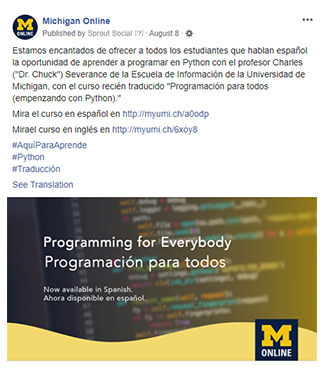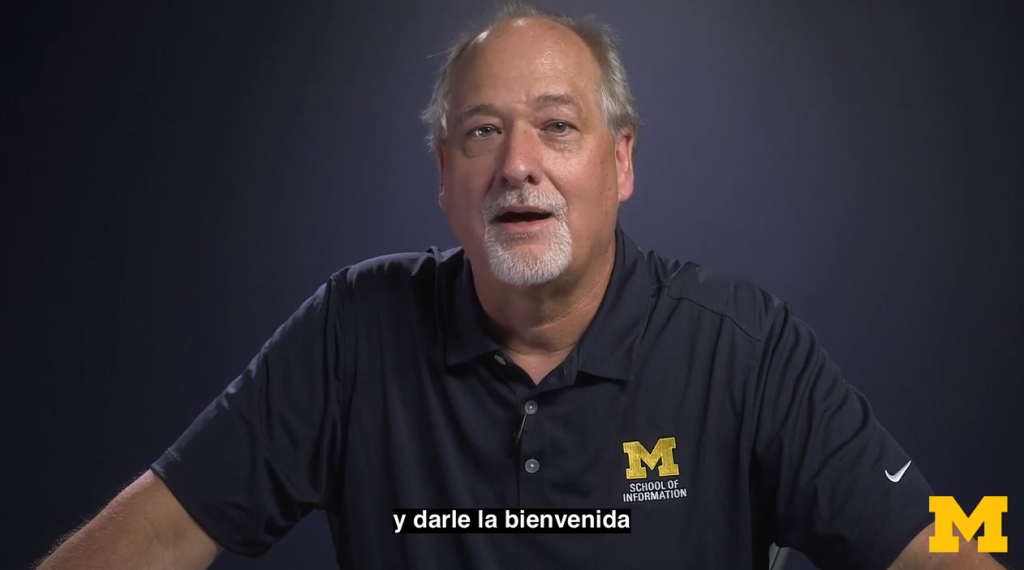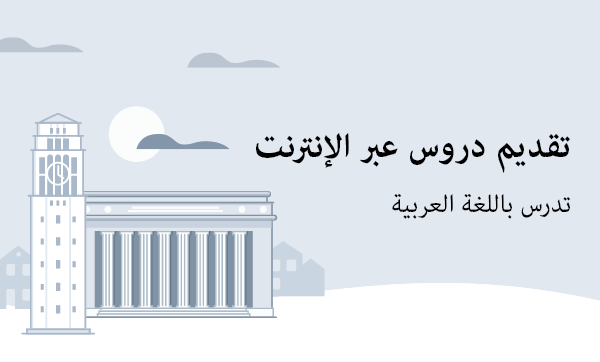Eric Joyce, Lead Marketing Specialist
@EricMJoyce
We appreciate our learners.
It’s true. At the University of Michigan and Center for Academic Innovation, we believe in increasing equitable access to education by connecting world-class faculty to learners around the globe.
Building a growing portfolio of massive open online courses (MOOCs) is one way in which we are acting on this belief, and we’re taking this a step further with an increasing library of partially translated courses for learners. My esteemed colleagues Jeff Bennet, Design Manager, and Bryon Maxey, Engagement Manager, shared their recommendations for translated course content for learners in a recent blog post, and I invite you to check it out.
These translations are an effort to invite more people to engage with this transformative content, learn from faculty experts, and grow a worldwide community of lifelong, maize and blue learners. We aspire to maintain this commitment through the process of promoting courses with Spanish and Arabic translations.
There’s just one problem; I don’t speak or write Spanish or Arabic, yet I want to communicate to our learners in these languages.
To help in this process, I needed to ask for help from my talented colleagues and leverage our available resources. The following are a few of my experiences when promoting our newly translated courses in Spanish and Arabic, as well as some additional considerations.
Including more of “Everybody” to “Programming for Everybody”
As mentioned in Jeff and Bryon’s excellent piece (again, go check it out), we recently translated the “Programming for Everybody (Getting Started with Python)” course from Charles (“Dr. Chuck”) Severance, PhD, Clinical Professor of Information in the School of Information, to both Arabic and Spanish.
Our Spanish-translated version of the course is available on edX’s Spanish-language platform at edx.org/es. In preparation for the launch of the Spanish-language version of “Programming for Everybody”, we worked with edX’s marketing and communications team for their Spanish platform. This team was instrumental in providing translation support for our promotional communications by providing translations of our social media and email copy. Leveraging specific targeting features through our email service provider and Facebook, we deployed our communications to the broader Michigan Online community simultaneously in both English and Spanish.


We also connected edX’s Spanish communications contacts with our own Spanish-language communications professionals to disseminate a joint press release on the translated course in Spanish (yes, that’s James DeVaney quoted in Spanish).
Through the encouragement of our edX partners, we also approached “Dr. Chuck” with an opportunity to speak directly to future Python programmers in Spanish in a special welcome video. I commend “Dr. Chuck” for his willingness to step outside of his comfort zone to connect directly with a new audience of learners — and learners responded:
- “¡Genial! ¿Cuándo empieza? ¿Ya está en [edX]?” (“Great! When does it start? Already in [edX]?”)
- “Muchas muchas gracias! Estimado Dr Chuck. Saludos” (“Thank you very very much! Dear Dr. Chuck. Regards”)
- “Dr. Chuck your Spanish is so so so funny. Thanks for giving us (the Spanish talking people) the opportunity to learn python in Spanish. Muchas muchas gracias!”

This extra effort to not only expand access to these learning experiences to a population of Spanish-speaking learners, but to actively welcome them to this new learning experience is indicative of the values of access and equity not only demonstrated by “Dr. Chuck,” but interwoven into our university mission.
Arabic Communication: A Crash Course
Earlier this year, we launched Arabic-translated versions of our “Leading Teams” and “Successful Negotiation: Essential Strategies and Skills” courses as well as the aforementioned “Programming for Everybody” course. Given how drastically different the Arabic alphabet is from English, I’m unable to speak or read the language — a problem when drafting a promotional email. Thankfully, Bryon recently completed an advanced Arabic program at U-M’s Center for Middle Eastern and North African Studies (CMENAS), and, along with help from his Sudanese language partner living in Saudi Arabia, provided an Arabic translation of an email I drafted in English.
However, the process of converting an email from English to Arabic is more nuanced than simply translating words from one language to another.
For starters, the Arabic language is written right-to-left, which necessitated a few design changes to accomodate this reading orientation. Most notably, we found we needed to transpose design elements in the header of our email for Arabic-speaking learners.


For this header and our social media posts, we encountered formatting challenges when inserting translated Arabic into design and editing software (ie. Adobe Illustrator). A direct copy and paste often breaks Arabic script and makes the language unintelligible. As with most problems, YouTube has a solution. Nevertheless, this is a consideration when trying to design promotional content for Arabic-speaking learners, especially in environments where translation resources are not readily available to verify accuracy.
I also learned punctuation is optional in Arabic. Common tools we like to use to make marketing promotion easily digestible to readers (exclamation points, colons, etc.) were not necessary. When we used any punctuation in our writing, we had to remember to appropriately insert it on the far left of our sentence.
The final product for our email was a unique accomplishment in my marketing career. We executed an email deployment to Arabic-speaking learners in a language that was completely foreign to me, in nearly every way possible. Best of all, our learners responded positively. The Arabic version of our email announcement had nearly double the open rate (email opens / number of total recipients) and the click rate (number of clicks / number email opens) of our email was 16 times higher compared to our English-language email. Unsurprisingly, it turns out learners appreciate communications in their native language.
Other Considerations when Promoting Courses in Foreign Languages
This is an emerging space for the Center for Academic Innovation. We’re continuing to encounter a number of questions and considerations in the process of promoting online learning experiences to learners who speak and read a language other than English. For example, there are a number of nuances in language dialects. Prior to deploying our Spanish email communications, we noticed a distinction in “Spanish – Spain” and “Spanish – Mexico” in our audience list. This prompted us to consider the language distinctions in our course and promotional content for Spanish-speaking learners in Latin America, Europe, and around the world. Similarly, there are multiple Arabic dialects. Which do we choose in our course content? In our promotion?
As we neared final drafts of our promotional content, we took another moment to consider cultural implications of our course images and prominent colors in our promotional materials. Although we didn’t find we needed to make any drastic changes, seemingly duplicative elements between versions of the course, such as the course image, may need a refresh to more accurately represent the cultural norms of the audience we are trying to reach.
Finally, when all else fails, I urge marketers to get started with Google Translate. We ran several first drafts of communications and on-the-spot translations through Google Translate as we finalized elements such as YouTube descriptions, email subject lines, etc. What we found was Google Translate was fairly accurate, but we always vetted these translations with someone who had advanced knowledge of the language. So, for marketers who find themselves in a situation with limited translation resources, Google Translate is a useful first step.


